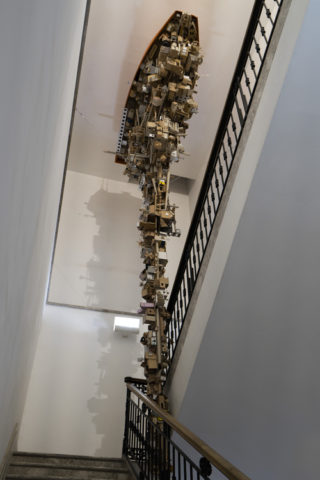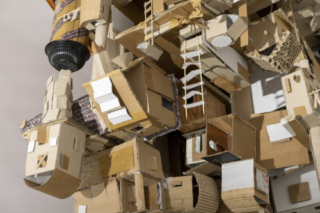
Pillar 2021
mixed media
Produced in collaboration with Dedalus Cooperativa Sociale, Accademia di Belle Arti Napoli
Commissioned for ‘Rethinking Nature’
Courtesy of the artists and Yavuz Gallery Singapore/Sydney

Pillar (detail) 2021
mixed media
Produced in collaboration with Dedalus Cooperativa Sociale, Accademia di Belle Arti Napoli
Commissioned for ‘Rethinking Nature’
Courtesy of the artists and Yavuz Gallery Singapore/Sydney
The artistic practice of Alfredo and Isabel Aquilizan centres on collaborative processes involving storytelling and participatory making in workshops that empower through shared creative experiences. For ‘Rethinking Nature’, the artists expand on Project Another Country, initiated in 2006 and inspired by the Badjao people, nomadic sailors of the Sulu Sea in the Philippines. This ongoing project addresses multiple understandings of the idea of home and questions orientations to individual forms of living through exploring communal proximity and co-existence. Pillar is composed of hundreds of houses developed by young people in workshops conducted in conjunction with Daedalus community association in Naples. Participants articulated their vision of home and the natural environment by imagining and constructing out of recycled cardboard. The cascade of these houses and gardens forming the installation descends across the floors of the museum, suspended from a Neapolitan sailboat, inverted like a shelter in a storm, in reference to the city’s history as a Mediterranean port, as well as to future forms of living on water that rising sea levels will generate. Embodying processes of collective intelligence and collaboration, the work articulates a multi-vocal vision of living in connection with surrounding ecologies.
Artists’ statement
Our work is collective in spirit and deploys strategies of accumulating and rearranging physical objects and narratives. Often communities and the audience are invited to engage proactively in the production of the artwork, ultimately creating shared experiences that are initiated by collecting stories that are displaced and transformed by means of meticulous reorganization. In this way our projects build, multiply and dissect collective memories and our hopes for the future.